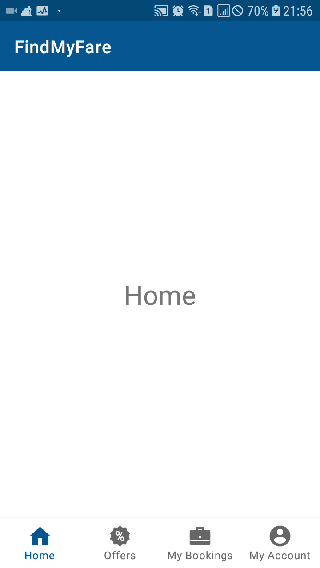I have an application which has a bottom menu bar which users can use to switch between 4 home page tabs. It's working fine like below.

The only problem I'm having is it showing back button when I switch between different fragment. Since all these fragments are at the same level I do not want it to behave like that.
This is my implementation.
MainNavigationActivity
class MainNavigationActivity : AppCompatActivity() {
private lateinit var navigationController: NavController
override fun onCreate(savedInstanceState: Bundle?) {
super.onCreate(savedInstanceState)
setContentView(R.layout.activity_main)
initialization()
}
private fun initialization(){
navigationController = Navigation.findNavController(this, R.id.hostFragment)
setSupportActionBar(toolbar)
NavigationUI.setupWithNavController(bottomNavigationBar,navigationController)
NavigationUI.setupActionBarWithNavController(this,navigationController)
}
override fun onBackPressed() {
onSupportNavigateUp()
}
MainNavigationActivity Layout
<RelativeLayout
xmlns:android="http://schemas.android.com/apk/res/android"
xmlns:tools="http://schemas.android.com/tools"
xmlns:app="http://schemas.android.com/apk/res-auto"
android:layout_width="match_parent"
android:layout_height="match_parent"
tools:context=".activities.MainNavigationActivity">
<androidx.appcompat.widget.Toolbar
android:id="@+id/toolbar"
android:layout_width="match_parent"
android:layout_height="wrap_content"
android:layout_alignParentTop="true"
android:background="@color/colorPrimary"
app:popupTheme="@style/ThemeOverlay.AppCompat.Light"
app:theme="@style/ThemeOverlay.AppCompat.Dark.ActionBar"/>
<fragment
android:id="@+id/hostFragment"
android:name="androidx.navigation.fragment.NavHostFragment"
android:layout_width="match_parent"
android:layout_height="wrap_content"
android:layout_below="@id/toolbar"
android:layout_above="@id/bottomNavigationBar"
app:defaultNavHost="true"
app:navGraph="@navigation/main_navigation_graph" />
<com.google.android.material.bottomnavigation.BottomNavigationView
android:id="@+id/bottomNavigationBar"
android:layout_width="match_parent"
android:layout_height="wrap_content"
android:layout_alignParentBottom="true"
android:background="@android:color/white"
app:menu="@menu/bottom_navigation_menu"
app:labelVisibilityMode="labeled"/>
</RelativeLayout>
bottom_navigation_menu.xml
<menu xmlns:android="http://schemas.android.com/apk/res/android">
<item
android:id="@+id/navigation_home"
android:state_checked="true"
android:color="@color/colorPrimary"
android:title="@string/navigation_home"
android:icon="@drawable/ic_bottom_bar_menu_home"/>
<item
android:id="@+id/navigation_offers"
android:state_checked="false"
android:color="@color/gray"
android:title="@string/navigation_offers"
android:icon="@drawable/ic_bottom_bar_menu_offers"/>
<item
android:id="@+id/navigation_my_bookings"
android:state_checked="false"
android:color="@color/gray"
android:title="@string/navigation_my_bookings"
android:icon="@drawable/ic_bottom_bar_menu_bookings"/>
<item
android:id="@+id/navigation_my_account"
android:state_checked="false"
android:color="@color/gray"
android:title="@string/navigation_my_account"
android:icon="@drawable/ic_bottom_bar_menu_account"/>
</menu>
The Ids are given to the fragments in the navigation graph and the ids in the menu.xml are the same. that's how it identifies the correct fragment and switch to that fragment correctly.
How can I remove this back button on the toolbar in home screen level?
Touch “Settings” -> “Display” -> “Navigation bar” -> “Buttons” -> “Button layout”. Choose the pattern in “Hide navigation bar” -> When the app opens, the navigation bar will be automatically hidden and you can swipe up from the bottom corner of the screen to show it.
Implement custom back navigation. ComponentActivity , the base class for FragmentActivity and AppCompatActivity , allows you to control the behavior of the Back button by using its OnBackPressedDispatcher , which you can retrieve by calling getOnBackPressedDispatcher() .
The action bar is a primary toolbar inside an activity that can be used to display an activity title and other interactive items. One of the most used items is a Back Navigation Button.
As per the NavigationUI documentation:
By default, the Navigation button is hidden when a user is at a top-level destination of a navigation graph and appears as an Up button in any other destination.
If you want to customize which destinations are considered top-level destinations, you can instead pass a set of destination IDs to the constructor, as shown below:
val appBarConfiguration = AppBarConfiguration(setOf(
R.id.navigation_home, R.id.navigation_offers,
R.id.navigation_my_bookings, R.id.navigation_my_account))
(Note that this constructor requires the navigation-ui-ktx artifact - the alternative is to use the AppBarConfiguration.Builder)
If you love us? You can donate to us via Paypal or buy me a coffee so we can maintain and grow! Thank you!
Donate Us With